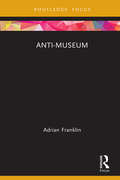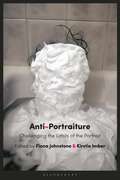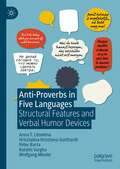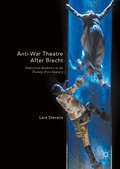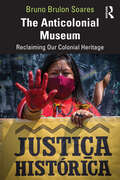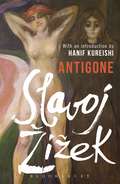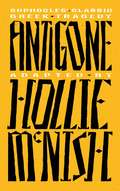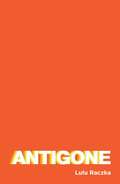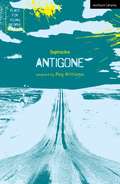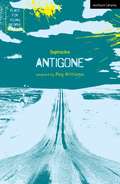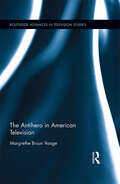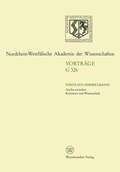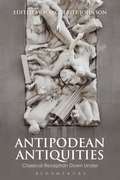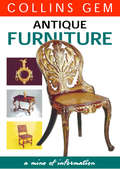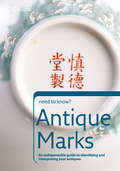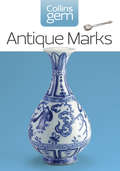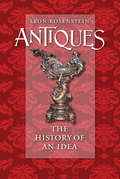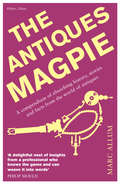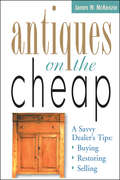- Table View
- List View
Anti-Museum (Museums in Focus)
by Adrian FranklinAnti-Museum charts the development of the anti-museum as a concept and as it has been realised in practice. Drawing on a range of case studies, including the New Museum and PS1 in New York, Mona in Australia, Art42 in Paris and Donald Judd’s Marfa, the book assesses their potential to engage museum publics in new ways. Anti-museums seek to breathe relational and theatricalised vitality into the objects they exhibit, by connecting them to the contexts of their making, to their social life outside the museum, to visitors' lives via their transformative capacities for change, and by being a place of dialogue, exchange and transformation, rather than instruction. Documenting the ways in which they have been created by artists, collectors, and curators, the book also examines the extent to which anti-museums connect with other museums through the exchange of values and resources. Critically, it asks whether, after some 40 years of ‘new museology’, such institutions are still able to offer something fresh and valuable. Anti-Museum provides a sharp and incisive account of the anti-museum as it has been imagined, realised and experienced, and as it has relevance for understanding and working in the contemporary museum world. As such, the book will be of great interest to scholars and students engaged in the study of museums, cultural economy, inclusive urban regeneration, the democratisation of art and contemporary art. It should also appeal to museum professionals around the world.
Anti-Museum (Museums in Focus)
by Adrian FranklinAnti-Museum charts the development of the anti-museum as a concept and as it has been realised in practice. Drawing on a range of case studies, including the New Museum and PS1 in New York, Mona in Australia, Art42 in Paris and Donald Judd’s Marfa, the book assesses their potential to engage museum publics in new ways. Anti-museums seek to breathe relational and theatricalised vitality into the objects they exhibit, by connecting them to the contexts of their making, to their social life outside the museum, to visitors' lives via their transformative capacities for change, and by being a place of dialogue, exchange and transformation, rather than instruction. Documenting the ways in which they have been created by artists, collectors, and curators, the book also examines the extent to which anti-museums connect with other museums through the exchange of values and resources. Critically, it asks whether, after some 40 years of ‘new museology’, such institutions are still able to offer something fresh and valuable. Anti-Museum provides a sharp and incisive account of the anti-museum as it has been imagined, realised and experienced, and as it has relevance for understanding and working in the contemporary museum world. As such, the book will be of great interest to scholars and students engaged in the study of museums, cultural economy, inclusive urban regeneration, the democratisation of art and contemporary art. It should also appeal to museum professionals around the world.
Anti-Portraiture: Challenging the Limits of the Portrait
by Fiona Johnstone/Kirstie ImberThe portrait has historically been understood as an artistic representation of a human subject. Its purpose was to provide a visual or psychological likenesses or an expression of personal, familial or social identity; it was typically associated with the privileged individual subject of Western modernity. Recent scholarship in the humanities and social sciences however has responded to the complex nature of twenty-first century subjectivity and proffered fresh conceptual models and theories to analyse it.The contributors to Anti-Portraiture examine subjectivity via a range of media including sculpture, photography and installation, and make a convincing case for an expanded definition of portraiture. By offering a timely reappraisal of the terms through which this genre is approached, the chapter authors volunteer new paradigms in which to consider selfhood, embodiment and representation. In doing so they further this exciting academic debate and challenge the curatorial practices and acquisition policies of museums and galleries.
Anti-Portraiture: Challenging the Limits of the Portrait
The portrait has historically been understood as an artistic representation of a human subject. Its purpose was to provide a visual or psychological likenesses or an expression of personal, familial or social identity; it was typically associated with the privileged individual subject of Western modernity. Recent scholarship in the humanities and social sciences however has responded to the complex nature of twenty-first century subjectivity and proffered fresh conceptual models and theories to analyse it.The contributors to Anti-Portraiture examine subjectivity via a range of media including sculpture, photography and installation, and make a convincing case for an expanded definition of portraiture. By offering a timely reappraisal of the terms through which this genre is approached, the chapter authors volunteer new paradigms in which to consider selfhood, embodiment and representation. In doing so they further this exciting academic debate and challenge the curatorial practices and acquisition policies of museums and galleries.
Anti-Proverbs in Five Languages: Structural Features and Verbal Humor Devices
by Wolfgang Mieder Anna T. Litovkina Hrisztalina Hrisztova-Gotthardt Péter Barta Katalin VarghaThis book is the first comparative study of English, German, French, Russian and Hungarian anti-proverbs based on well-known proverbs. Proverbs are by no means fossilized texts but are adaptable to different times and changed values. While anti-proverbs can be considered as variants of older proverbs, they can also become new proverbs reflecting a more modern worldview. Anti-proverbs are therefore a lingo-cultural phenomenon that deserves the attention of cultural and literary historians, folklorists, linguists, and general readers interested in language and wordplay.
Anti-War Theatre After Brecht: Dialectical Aesthetics in the Twenty-First Century
by Lara StevensExamining the ways in which contemporary Western theatre protests against the ‘War on Terror’, this book analyses six twenty-first century plays that respond to the post-9/11 military operations in Afghanistan, Iraq and Palestine. The plays are written by some of the most significant writers of this century and the last including Elfriede Jelinek, Caryl Churchill, Hélène Cixous and Tony Kushner. Anti-war Theatre After Brecht grapples with the problem of how to make theatre that protests the policies of democratically elected Western governments in a post-Marxist era. It shows how the Internet has become a key tool for disseminating anti-war play texts and how online social media forums are changing traditional dramatic aesthetics and broadening opportunities for spectator access, engagement and interaction with a work and the political alternatives it puts forward.
The Anticolonial Museum: Reclaiming Our Colonial Heritage
by Bruno Brulon SoaresThe Anticolonial Museum acknowledges some of the consequences of colonialism in the current work of museums. Looking at museum theory in a critical way, it proposes a radical revision of museums’ rhetoric on decolonisation, as well as their public image and practices. Bringing together a collection of reflections on decolonisation through the observation of museum performance and discourse, the author considers current practices in response to the social claims of marginalised groups and activists. Drawing from a genealogy of decolonial thinking in museology, Brulon Soares identifies the inherent paradoxes reflected in museum work. The book’s focus is not exclusively on the reality of colonised countries, nor on the context of former imperialist nations—instead, it raises anticolonial questions, finding common ground between the different actors involved in the museum: scholars, students, curators, practitioners, community members and Indigenous creators. One of the central aims of this book is to view the museum as a locus for multiple enunciations, thus identifying in museum practice the active possibility of reconnecting subjectivities and restoring material fluxes to effectively repair the bonds that have been frayed by colonialism and an expanding modernity. The Anticolonial Museum will be of great interest to researchers and students engaged in the study of decolonisation. It will also be essential for practitioners who wish to reconsider the impact of coloniality on their own position and everyday practice.
The Anticolonial Museum: Reclaiming Our Colonial Heritage
by Bruno Brulon SoaresThe Anticolonial Museum acknowledges some of the consequences of colonialism in the current work of museums. Looking at museum theory in a critical way, it proposes a radical revision of museums’ rhetoric on decolonisation, as well as their public image and practices. Bringing together a collection of reflections on decolonisation through the observation of museum performance and discourse, the author considers current practices in response to the social claims of marginalised groups and activists. Drawing from a genealogy of decolonial thinking in museology, Brulon Soares identifies the inherent paradoxes reflected in museum work. The book’s focus is not exclusively on the reality of colonised countries, nor on the context of former imperialist nations—instead, it raises anticolonial questions, finding common ground between the different actors involved in the museum: scholars, students, curators, practitioners, community members and Indigenous creators. One of the central aims of this book is to view the museum as a locus for multiple enunciations, thus identifying in museum practice the active possibility of reconnecting subjectivities and restoring material fluxes to effectively repair the bonds that have been frayed by colonialism and an expanding modernity. The Anticolonial Museum will be of great interest to researchers and students engaged in the study of decolonisation. It will also be essential for practitioners who wish to reconsider the impact of coloniality on their own position and everyday practice.
Antigone
by Slavoj ŽižekAntigone is universally celebrated as the ultimate figure of ethical resistance to the state power which oversteps its legitimate scope and as the defender of simple human dignity (more important than all political struggles). But is she really so innocent and pure? What if there is a dark side to her? What if Creon, the representative of state power, also has a valuable point to make? And what if both Antigone and Creon are part of a problem that only a popular intervention can confront?Žižek's rewriting of this classic play confronts these issues in a practical way: not by theorizing about them, but by imagining an Antigone in which, at a crucial moment, the action takes a different turn, an Antigone along the lines of Run, Lola, Run or of Brecht's learning plays. A brilliantly funny, moving and political piece for those who are interested in reading and watching Antigone in an entirely new way.
Antigone
by Slavoj ŽižekAntigone is universally celebrated as the ultimate figure of ethical resistance to the state power which oversteps its legitimate scope and as the defender of simple human dignity (more important than all political struggles). But is she really so innocent and pure? What if there is a dark side to her? What if Creon, the representative of state power, also has a valuable point to make? And what if both Antigone and Creon are part of a problem that only a popular intervention can confront?Žižek's rewriting of this classic play confronts these issues in a practical way: not by theorizing about them, but by imagining an Antigone in which, at a crucial moment, the action takes a different turn, an Antigone along the lines of Run, Lola, Run or of Brecht's learning plays. A brilliantly funny, moving and political piece for those who are interested in reading and watching Antigone in an entirely new way.
Antigone: A New Adaptation of the Classic Greek Tragedy
by Hollie McNishA modern retelling of Sophocles' classic play, Antigone, by bestselling writer and poet Hollie McNishAs the daughter of Oedipus, Antigone was dealt a cruel hand at birth - even within the bounds of Grecian tragedy. When her brothers are slain fighting for the throne of Thebes, Antigone finds herself pitted against her uncle, the newly crowned King Creon. In defiance of the king, Antigone buries her brother's body, a choice she may pay for dearly.In this new adaptation, we see Sophocles' play reignited by bestselling poet and writer Hollie McNish. Hollie's considered retelling brings Sophocles' original text to a modern-day audience, illuminating the remarkable resemblances between ancient Greek thought and the society we grapple with today.'[Hollie McNish] writes with honesty, conviction, humour and love . . . She's always been one of my favourites' Kae Tempest
Antigone (Oberon Modern Plays)
by Lulu RaczkaThe war is over. The dead have been buried. The traitors have been punished. People feel more alive than they have in a long time. They are ready to start again. But Antigone is not. She will not move on, and she will not forget. She will drag everyone back if she has to. Lulu Raczka’s searing adaptation of Sophocles’ classic text hands the reins to the young women at its heart, creating something messy, irreverent and vital.
Antigone (Plays for Young People)
by Roy WilliamsWhen Creon refuses to bury the body of Antigone's unruly brother, Antigone's anger quickly turns to defiance. Creon condemns her to a torturous death: she's to be buried alive.Acclaimed playwright Roy Williams takes Sophocles' play and, by placing it into a contemporary setting, brings this classic tale vividly to life.A timeless story about loyalty and truth, about how we make meaning out of life and death, and what in the end really does matter.Roy Williams's adaptation of Antigone received its world premiere at Derby Theatre, in a co-production between Pilot Theatre, Derby Theatre and Theatre Royal, Stratford East, before going on a national tour. This new, edited edition is published for the first time in Methuen Drama's Plays for Young People series, aimed at 16-18 year olds.
Antigone (Plays for Young People)
by Roy WilliamsWhen Creon refuses to bury the body of Antigone's unruly brother, Antigone's anger quickly turns to defiance. Creon condemns her to a torturous death: she's to be buried alive.Acclaimed playwright Roy Williams takes Sophocles' play and, by placing it into a contemporary setting, brings this classic tale vividly to life.A timeless story about loyalty and truth, about how we make meaning out of life and death, and what in the end really does matter.Roy Williams's adaptation of Antigone received its world premiere at Derby Theatre, in a co-production between Pilot Theatre, Derby Theatre and Theatre Royal, Stratford East, before going on a national tour. This new, edited edition is published for the first time in Methuen Drama's Plays for Young People series, aimed at 16-18 year olds.
The Antihero in American Television (Routledge Advances in Television Studies)
by Margrethe Bruun VaageThe antihero prevails in recent American drama television series. Characters such as mobster kingpin Tony Soprano (The Sopranos), meth cook and gangster-in-the-making Walter White (Breaking Bad) and serial killer Dexter Morgan (Dexter) are not morally good, so how do these television series make us engage in these morally bad main characters? And what does this tell us about our moral psychological make-up, and more specifically, about the moral psychology of fiction? Vaage argues that the fictional status of these series deactivates rational, deliberate moral evaluation, making the spectator rely on moral emotions and intuitions that are relatively easy to manipulate with narrative strategies. Nevertheless, she also argues that these series regularly encourage reactivation of deliberate, moral evaluation. In so doing, these fictional series can teach us something about ourselves as moral beings—what our moral intuitions and emotions are, and how these might differ from deliberate, moral evaluation.
The Antihero in American Television (Routledge Advances in Television Studies)
by Margrethe Bruun VaageThe antihero prevails in recent American drama television series. Characters such as mobster kingpin Tony Soprano (The Sopranos), meth cook and gangster-in-the-making Walter White (Breaking Bad) and serial killer Dexter Morgan (Dexter) are not morally good, so how do these television series make us engage in these morally bad main characters? And what does this tell us about our moral psychological make-up, and more specifically, about the moral psychology of fiction? Vaage argues that the fictional status of these series deactivates rational, deliberate moral evaluation, making the spectator rely on moral emotions and intuitions that are relatively easy to manipulate with narrative strategies. Nevertheless, she also argues that these series regularly encourage reactivation of deliberate, moral evaluation. In so doing, these fictional series can teach us something about ourselves as moral beings—what our moral intuitions and emotions are, and how these might differ from deliberate, moral evaluation.
Antike zwischen Kommerz und Wissenschaft 25 Jahre Erwerbungen für das Akademische Kunstmuseum Bonn (Mathematische Methoden der Technik #326)
by Nikolaus HimmelmannAntipodean Antiquities: Classical Reception Down Under (Bloomsbury Studies in Classical Reception)
by Marguerite JohnsonLeading and emerging, early career scholars in Classical Reception Studies come together in this volume to explore the under-represented area of the Australasian Classical Tradition. They interrogate the interactions between Mediterranean Antiquity and the antipodean worlds of New Zealand and Australia through the lenses of literature, film, theatre and fine art.Of interest to scholars across the globe who research the influence of antiquity on modern literature, film, theatre and fine art, this volume fills a decisive gap in the literature by bringing antipodean research into the spotlight. Following a contextual introduction to the field, the six parts of the volume explore the latest research on subjects that range from the Lord of the Rings and Xena: Warrior Princess franchises to important artists such as Sidney Nolan and local authors whose work offers opportunities for cross-cultural and interdisciplinary analysis with well-known Western authors and artists.
Antipodean Antiquities: Classical Reception Down Under (Bloomsbury Studies in Classical Reception)
by Marguerite JohnsonLeading and emerging, early career scholars in Classical Reception Studies come together in this volume to explore the under-represented area of the Australasian Classical Tradition. They interrogate the interactions between Mediterranean Antiquity and the antipodean worlds of New Zealand and Australia through the lenses of literature, film, theatre and fine art.Of interest to scholars across the globe who research the influence of antiquity on modern literature, film, theatre and fine art, this volume fills a decisive gap in the literature by bringing antipodean research into the spotlight. Following a contextual introduction to the field, the six parts of the volume explore the latest research on subjects that range from the Lord of the Rings and Xena: Warrior Princess franchises to important artists such as Sidney Nolan and local authors whose work offers opportunities for cross-cultural and interdisciplinary analysis with well-known Western authors and artists.
Antique Furniture (Collins Gem)
by CollinsCollins Gem Antique Furniture is a guide to take with you to auctions or car boot sales for it provides a visual guide to identifying the age and style of furniture, combined with advice on caring, buying, and selling antique furniture.
Antique Marks (Collins Need to Know?)
by CollinsThis handy guide to identifying and interpreting gold, silver, platinum and ceramic marks includes all hallmarks from 1544. Details of the new hallmarking system, international marks and guides to the great makers are all included.
Antique Marks: Find The Mark To Make You Rich! (Collins Gem)
by Anna Selby The Diagram GroupThis pocket-sized guide to identifying and interpreting metal and ceramic marks has been improved with the addition of the most recent hallmarks, along with details of the new hallmarking system.
Antiques: The History of an Idea
by Leon RosensteinThe notion of retrieving a bit of the past-by owning a material piece of it-has always appealed to humans. Often our most prized possessions are those that have had a long history before they came into our hands. Part of the pleasure we gain from the encounter with antiques stems from the palpable age and the assumed (sometimes imaginary) cultural resonances of the particular object. But precisely what is it about these objects that creates this attraction? What common characteristics do they share and why and how do these traits affect us as they do? In Antiques: The History of an Idea, Leon Rosenstein, a distinguished philosopher who has also been an antiques dealer for more than twenty years, offers a sweeping and lively account of the origin and development of the antique as both a cultural concept and an aesthetic category. He shows that the appeal of antiques is multifaceted: it concerns their value as commodities, their age and historical and cultural associations, their uniqueness, their sensuous and tactile values, their beauty. Exploring how the idea of antiques evolved over time, Rosenstein chronicles the history of antique collecting and connoisseurship. He describes changing conceptions of the past in different epochs as evidenced by preservations, restorations, and renascences; examines shifting attitudes toward foreign cultures as revealed in stylistic borrowings and the importation of artifacts; and investigates varying understandings of and meanings assigned to their traits and functions as historical objects.While relying on the past for his evidence, Rosenstein approaches antiques from an entirely original perspective, setting history within a philosophical framework. He begins by providing a working definition of antiques that distinguishes them from other artifacts in general and, more distinctly, both from works of fine art and from the collectible detritus of popular culture. He then establishes a novel set of criteria for determining when an artifact is an antique: ten traits that an object must possess in order to elicit the aesthetic response that is unique to antiques. Concluding with a provocative discussion of the relation between antiques and civilization, this engaging and thought-provoking book helps explain the enduring appeal of owning a piece of the past.
The Antiques Magpie: A compendium of absorbing history, stories and facts from the world of antiques (Magpie Ser.)
by Marc AllumFrom the mythical artefacts of the ancient world to saucy seaside postcards, The Antiques Magpie explores the wonderful world of antiques and collectables. With Antiques Roadshow regular Marc Allum as your guide, go in search of stolen masterpieces, explore the first museums, learn the secrets of the forgers and brush up on your auction technique. Meet the garden gnome insured for £1 million, track down Napoleon’s toothbrush, find out how to spot a corpse in a Victorian photograph – and much more. This book is for anyone who’s ever been fascinated by what relics of the past tell us about history – and what they are worth today.
Antiques on the Cheap: A Savvy Dealer's Tips: Buying, Restoring, Selling
by James W. McKenzieGet the inside scoop on every aspect of antiquing - buying, cleaning, repairing, embellishing, refinishing, restoring, and selling. You'll find expert advice for getting great deals at auctions, flea markets, and shops, and you'll learn how to spot items that can be repaired to increase their value. Advice for selling antiques at flea markets, on consignment, and in shops is included.
